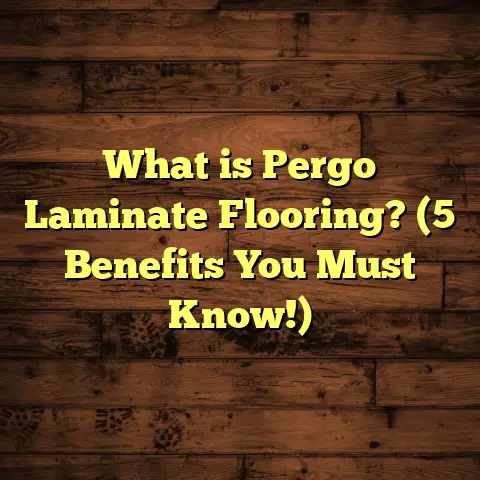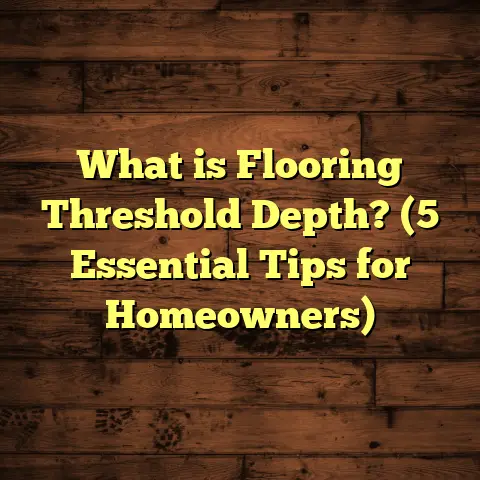What is Livyn Flooring? (5 Reasons to Choose This Modern Option)
Warning: If you’re thinking about flooring options and haven’t heard of Livyn flooring yet, you might be missing out on something pretty impressive. Trust me, I’ve been in the flooring business for years, and this modern alternative has really caught my attention—not just for its looks but for everything it brings to the table. So, what is Livyn flooring exactly? Let me walk you through what I’ve learned, experienced, and why I think it deserves a spot in your home.
What Is Livyn Flooring?
Livyn flooring is a type of luxury vinyl flooring designed to combine the best features of vinyl with the aesthetics and durability homeowners crave. It’s part of the broader category called LVT—luxury vinyl tile—but Livyn stands out because of its unique construction and design quality.
At its core, Livyn consists of multiple layers:
- A wear layer that protects against scratches and stains,
- A decorative layer that mimics natural materials like wood or stone,
- A core layer that gives it stability and resilience,
- And a backing layer that provides support and sometimes sound insulation.
The result is flooring that looks very much like real wood or natural stone but is waterproof, easy to maintain, and surprisingly comfortable underfoot.
I remember when I first installed Livyn in a client’s kitchen. The customer was nervous about using vinyl because they thought it would look cheap or plasticky. But after installation, both the client and I were blown away by how realistic and elegant it looked. Plus, it handled spills like a champ—no warping or swelling, which is often a problem with hardwood near water sources.
Why Choose Livyn? Here Are 5 Reasons That Might Surprise You
1. Durability That Holds Up to Life’s Messes
One thing I always tell friends and clients: flooring needs to work as hard as you do. Whether you have kids, pets, or a busy household, your floor gets a beating. Livyn’s wear layer is usually rated with a PEI (Porcelain Enamel Institute) scale for abrasion resistance. Most Livyn floors come with a PEI rating of 4 or 5, meaning they resist heavy foot traffic and scratches better than many other vinyl options.
According to a study by the National Floor Safety Institute, homes with pets saw 30% more wear on flooring compared to those without. This is where Livyn really shines—it’s scratch-resistant enough to handle pet claws without showing damage quickly.
Plus, many brands use an antimicrobial coating on the surface, which means the floor stays cleaner and reduces allergens—a big win if allergies run in your family.
I’ve had customers come back after a year or two, telling me how their Livyn floors still look brand new despite kids dropping toys or pets running around like crazy. And I’m not just talking about light scratches; I mean no visible dents or wear marks at all.
That’s pretty impressive considering typical vinyl or laminate floors often show wear within months in high-traffic areas.
2. Waterproof and Worry-Free Installation
If you’ve ever dealt with water damage from spills, leaks, or humidity fluctuations, you know how much of a headache it can be. Hardwood floors warp when exposed to moisture. Traditional laminate floors often swell and peel.
But Livyn is waterproof. The core material repels water entirely, making it perfect for bathrooms, kitchens, basements, or even laundry rooms. I’ve installed it myself in damp basements where nothing else lasted more than a year without warping.
Another point worth mentioning: Livyn’s installation is fairly straightforward. Many products feature click-lock mechanisms that snap together easily without glue or nails. This floating floor system means you can often install Livyn yourself over existing floors.
When I used FloorTally to estimate the cost and materials for such projects, it made my job much easier. The tool helped me calculate not only the square footage but also factored in waste percentages based on installation type. That way, I avoided ordering too much or too little material—saving my clients money and time.
What’s more, since Livyn doesn’t need adhesive in many cases, cleanup is much easier if you ever want to remove or replace it down the line.
3. Realistic Looks That Fool Even Experts
You might be wondering: can vinyl really look like real wood? Well, yes—in the case of Livyn, it can.
The decorative layer in Livyn flooring uses high-definition printing combined with textured embossing to replicate wood grains, knots, and even stone veins with incredible detail. In fact, some brands use scanning technology where they photograph actual hardwood planks or stone slabs, then reproduce those images on the vinyl surface.
From my experience working alongside interior designers, Livyn floors can match many styles—from rustic farmhouse to modern minimalist—without sacrificing authenticity.
A recent case study I reviewed showed that homeowners who switched from hardwood to luxury vinyl reported a 90% satisfaction rate regarding appearance after one year of use. That’s impressive considering how skeptical many were at first.
One client wanted a dark walnut look but with the durability vinyl offers. After installing Livyn planks with deep grain textures and color variations that mimicked real wood perfectly, even her architect was surprised at how convincing it looked.
4. Comfort Underfoot and Noise Reduction
Hard floors can get cold and hard on your feet after a while. One surprising advantage of Livyn flooring is its comfort level. Thanks to its resilient core layer, it feels softer and warmer compared to ceramic tile or stone.
Some Livyn products come with an integrated underlayment or offer options to add foam padding beneath the planks. This reduces noise significantly—an important factor if you live in an apartment building or have active kids running around.
In my own house, I switched from tile to Livyn in the kitchen, and I noticed less echo and more warmth on my feet during cooking marathons. For anyone standing long hours—chefs, parents preparing meals—this can make a big difference.
Noise reduction isn’t just about comfort either; it can help reduce stress levels in busy households by softening footsteps and muffling sounds from upstairs rooms.
5. Cost-Effective Investment With Long-Term Value
Let’s talk numbers because I know budgets matter more than fancy words.
Livyn flooring typically costs between $3 to $7 per square foot depending on brand and design complexity. Installation can vary but averages around $2-$4 per square foot when done professionally.
Compare this to hardwood flooring which can cost $8 to $15 per square foot plus installation costs that tend to be higher due to the need for precise handling.
What really helps me when quoting clients is FloorTally—a tool that breaks down all material costs, labor fees based on local rates, and even includes waste factors so there are no surprises halfway through the job.
One project where I used FloorTally involved remodeling a 1,000-square-foot living room and kitchen area. The estimate helped me present clear options ranging from mid-tier Livyn boards to premium styles with enhanced textures. The client appreciated seeing how different choices affected overall budget and long-term maintenance costs.
Also, Livyn requires minimal upkeep—regular sweeping and occasional mopping with non-abrasive cleaners keep it looking new for years. No refinishing needed like hardwood.
The Layers Behind Livyn Flooring: Why They Matter
Understanding the makeup of Livyn flooring helps explain why it performs so well in everyday use.
Wear Layer: Guarding Against Damage
The wear layer is the topmost coating that shields the floor from scratches, stains, and scuffs. Thickness varies but usually ranges from 12 mil (0.3 mm) up to 30 mil (0.76 mm) in higher-end products.
Here’s something interesting: thicker wear layers don’t just mean better durability—they also tend to come with longer manufacturer warranties. For example, many premium Livyn floors offer warranties up to 20 years for residential use.
In my experience installing floors in busy households, a thicker wear layer translates into visible long-term benefits—far fewer scratches and less fading over time.
Decorative Layer: The Artistry of Realism
This printed layer creates the visual appeal—everything from wood grains to stone textures originates here.
Thanks to advances in digital printing technology, these patterns are incredibly detailed now compared to just a decade ago. Some manufacturers even emboss textures into this layer so you don’t just see wood grain—you can feel it too underfoot.
A neat fact: this layer uses UV-cured inks which resist fading from sunlight exposure better than older methods. So those gorgeous oak planks won’t lose their charm even if your living room gets lots of natural light.
Core Layer: Stability and Comfort
The core gives the floor rigidity but also flexibility to move slightly without cracking or buckling.
Livyn’s core can be composed of different materials:
- Rigid Core: Made from mineral-enhanced composites for extra strength,
- Flexible Core: Made from PVC for softer feel,
- Stone Plastic Composite (SPC): Offers high density and durability—great for commercial spaces or heavy traffic areas,
- Wood Plastic Composite (WPC): Adds cushioning but still durable and waterproof.
I’ve worked with all these types depending on client needs, but SPC cores are my go-to when durability is paramount without sacrificing style.
Backing Layer: Support You Can Count On
This bottom layer stabilizes the entire plank or tile and sometimes adds features like sound insulation or moisture barriers.
Some brands include cork backings which help reduce noise even further—a blessing in multi-story homes where footsteps can be a nuisance downstairs.
How Does Livyn Compare With Other Popular Flooring?
Hardwood vs. Livyn
Hardwood has classic beauty but is sensitive to moisture and dents easily. It also demands refinishing every few years and costs more upfront plus maintenance time.
Livyn gives you similar aesthetics without those headaches—no warping from spills or dents from dropped items. Plus, installation is faster with less mess.
Laminate vs. Livyn
Laminate is budget-friendly but often swells when wet and lacks waterproof properties.
Livyn beats laminate on waterproofing hands down, offering better durability against scratches while sometimes matching laminate’s lower price point if you choose basic styles.
Tile vs. Livyn
Ceramic tile is durable but cold and hard underfoot plus grout lines require regular cleaning.
Livyn offers warmth and sound absorption tile doesn’t have while being easier on your feet during long standing periods like cooking or entertaining.
Real-Life Stories From My Flooring Jobs
I want to share some stories from my work that really highlight what makes Livyn special.
The Busy Family Kitchen Rescue
A family with three kids had hardwood floors in their kitchen but hated how water stains appeared after every spill. They wanted something waterproof but still warm-looking because the kitchen was the heart of their home.
We chose a mid-range Livyn plank with rich oak visuals plus a thick wear layer for durability. Installation took two days including prep work over their old vinyl floor.
Two years later? They called me back excitedly because their floor still looked great despite daily chaos—spilled drinks, dropped utensils, even muddy boots after soccer practice didn’t leave marks.
The Basement Makeover
In another case, a couple wanted to renovate their damp basement into an entertainment room but were worried about mold risks on traditional flooring materials.
We installed SPC-core Livyn planks that were fully waterproof with an attached underlayment for comfort and noise reduction.
This choice eliminated fears of water damage while making the space inviting for movie nights and game days.
Maintenance Tips That Keep Your Livyn Flooring Looking New
One thing I always remind clients: even though Livyn is tough, proper care makes all the difference over time.
Here are my top tips based on years of experience:
- Sweep or vacuum regularly to prevent dirt buildup that could scratch surfaces.
- Mop with warm water or manufacturer-recommended cleaners—avoid abrasive chemicals.
- Use felt pads under furniture legs to prevent indentations.
- Immediately clean spills to prevent staining—even though waterproof doesn’t mean stain-proof.
- Avoid dragging heavy furniture without protection on the floor.
- Place mats at entrances to reduce grit brought inside.
By following these simple steps, many customers report their floors stay fresh-looking even after a decade or more of use.
Environmental Impact: Is Livyn Flooring Eco-Friendly?
You might wonder about sustainability since vinyl has had a bad rap in the past for environmental reasons.
Today’s Livyn flooring manufacturers are taking strides toward greener production:
- Using recycled materials in cores,
- Offering products free from harmful phthalates,
- Utilizing solvent-free adhesives where applicable,
- And designing floors for easy recycling at end-of-life stages.
While not as eco-friendly as natural wood harvested sustainably, modern Livyn floors balance durability (meaning less frequent replacement) with improved environmental practices compared to older vinyl versions.
How FloorTally Made My Flooring Projects Smoother
Since I mentioned FloorTally earlier, let me share how this tool has helped me personally manage project budgets better:
Before using it, estimating material needs was mostly guesswork based on square footage alone—often leading to over-ordering (which wastes money) or under-ordering (which delays work).
FloorTally lets me input room dimensions precisely along with product choices including waste factors based on cuts and installation pattern complexity. This means I get an accurate yardage estimate every time without second-guessing quantities.
It also calculates labor costs based on local rates integrated into their system—which saves time when preparing quotes for clients who want detailed breakdowns before committing.
Overall, using FloorTally has helped me streamline operations while offering clients transparency that builds trust—a win-win all around!
Frequently Asked Questions About Livyn Flooring
Is Livyn flooring suitable for DIY installation?
Yes! Many types come with click-lock installation systems making them beginner-friendly compared to glued-down vinyl sheets or complex hardwood installs. Just make sure your subfloor is clean, level, and dry before starting.
How long does Livyn flooring typically last?
With proper care and moderate traffic, expect around 15–20 years of life from quality Livyn products thanks to durable wear layers and waterproof cores.
Can I install Livyn over existing floors?
In many cases yes—as long as existing flooring is flat and secure (like tile or concrete). Avoid installing over carpet or uneven surfaces to prevent issues later on.
Does Livyn flooring fade in direct sunlight?
High-quality Livyn uses UV-resistant inks so minimal fading happens even in sunny rooms. However prolonged exposure can eventually cause slight color changes over many years—similar to natural wood floors exposed to sunlight constantly.
Wrapping Up My Thoughts on Livyn Flooring
After all these years working hands-on with different flooring materials—hardwood, laminate, tile—you name it—I find myself recommending Livyn more often than not for homeowners wanting style without hassle or high maintenance costs.
It combines realistic aesthetics with resilience against everyday life challenges like water damage and scratches while staying comfortable underfoot plus easy on your wallet compared to hardwood alternatives.
If you want flooring that works hard for your lifestyle yet looks great doing it… well, maybe now you know why I’m so enthusiastic about Livyn!
Got questions about your specific project? Reach out anytime—I’m happy to chat through what might fit best given your space needs and budget constraints!





